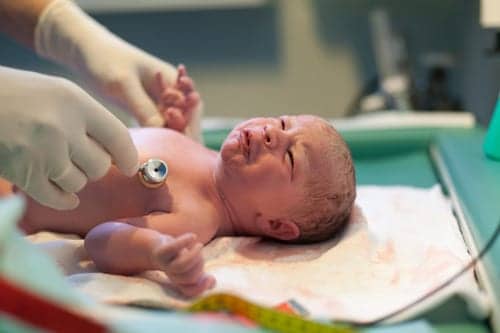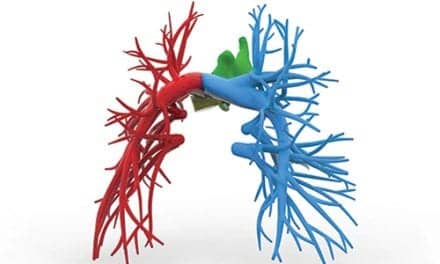RTs have numerous tools available to aid them in diagnosing and treating critically-ill newborns.
By John J. Ancy, MA, RRT
Caring for critically ill neonates is one of the most challenging and rewarding experiences in respiratory care. The knowledge and skill set for neonatal respiratory care are substantial. Blood gas sampling and analysis have long been a central component in caring for newborns. In nearly all hospitals, RTs are important members of the neonatal care team. With the increasing popularity of near-patient laboratory testing, or point-of-care testing (POCT), RTs are being offered a golden opportunity to further expand their role. This is particularly true in neonatal care, where fast response is requisite to good care. Many hospitals have recognized the advantages of moving blood gas analysis closer to patients.
In hospitals where central labs control blood gases, there is often resistance to moving blood gases to the point-of-care environment. The most frequent objections to POCT involve perceived higher per-test costs, accuracy of results, regulatory compliance, and other management issues. These considerations are important and valid concerns, but there can be no argument that a well-designed POCT program in the NICU can improve care. This improvement in care is directly related to reducing the time from draw to results, or improved turnaround time (TAT), particularly important in the care of critically ill infants. Near-patient blood gas analysis also reduces the potential for preanalytical errors, which can be significant in blood gas testing. Preanalytical errors are responsible for approximately 75% of errors in blood gas reporting.1 With near-patient testing, the potential for preanalytic errors from metabolism, transport conditions, and ambient air exposure is greatly reduced.
More Than a Blood Gas Analyzer
Furthermore, advances in blood gas analyzers, software, and networking have made it easier to maintain decentralized blood gas analysis and facilitate the growth of POCT. Many blood gas systems have reduced maintenance requirements, enabling caregivers to spend less care time with the analyzer and more time caring for patients. Additionally, networked analyzers linked with specialty blood gas software have greatly reduced the drudgery of managing operators, patient databases, and regulatory documentation. Blood gas analyzers are no longer simply “blood gas” analyzers. Over the last several decades, the analytic capability of whole blood analyzers has expanded greatly to include electrolyte, metabolite, and CO-Oximetry testing. The blood gas analyzer menu will continue expanding as whole blood analysis technology evolves with new capabilities. These represent new opportunities and responsibilities for respiratory therapists.
Analyzing electrolytes with blood gases improves the ability to assess electrolyte equilibrium along with acid-base balance. Many acid-base disturbances are associated with electrolyte shifts or can be caused by electrolyte imbalance. For example, hypokalemia can result in muscle weakness, arrhythmia, and cardiac arrest at <3.0 mmol/L.2 Single-sample, concurrent analysis of blood gases and electrolytes capability greatly improves the diagnostic utility of whole blood sample analysis in the NICU. To correctly employ this blood gas analyzer enhancement, RTs should refresh or improve their knowledge of acid-base and electrolyte interactions. This electrolyte analysis also requires additional preanalytic precautions. If electrolytes are added to the blood gas menu, lithium heparin, rather than sodium heparin, should be used as the anticoagulant. If ionized calcium is reported with blood gas electrolytes, a low concentration lithium heparin or electrolyte balanced lithium heparin syringe is recommended, as heparin complexes ionized calcium.
Which Sample Do I Use?
The classic blood gas menu of pH, pCO2, pO2, and bicarbonate is very useful in determining acid-base balance and oxygenation (see Table below). The arterial sample is preferred for acid-base and oxygenation assessment. Samples drawn by arterial puncture or from in-dwelling arterial catheters are routinely used in NICUs. Precautions, particularly in neonates, are numerous for both types of sampling. Arterial sampling in neonates is quite difficult due to the size of vessels, whose very small arterial lumens tend to increase the risk of thrombosis. Umbilical catheter lines, kept patent with continuous infusion of heparinized intravenous solution, are the most frequently used in-dwelling catheters in neonates. Failure to withdraw adequate waste volume prior to the sample draw is one of the most frequent preanalytic errors associated with line draws. Volume of waste to be removed should be two times the sampling port/line dead space, to minimize sample contamination.3 Removal of lesser waste volumes can result in inaccurate sample results, while removal of higher waste volumes can result in unacceptably high blood loss, particularly in very ill infants who require frequent arterial blood gas testing.
Capillary samples also are frequently used in NICU blood gas analysis. Capillary samples provide a reasonable approximation of arterial pH and pCO2, but tend to underestimate pO2. The recommendation to arterialize the capillary puncture site by prewarming cannot be overemphasized. This practice not only improves blood flow and eases collection, but it also tends to bring the pO2 closer to that of an arterial sample. Electrolyte values from capillary samples are generally unreliable, due to hemolysis, which elevates potassium and decreases sodium. This is particularly true if the sampling site is squeezed or “milked” in filling the capillary tube.2 Peripheral venous samples provide a reasonable estimation of arterial pH, but have virtually no value in assessing gas exchange. Either arterial or peripheral venous samples can be analyzed for electrolytes. If both blood gases and electrolytes are required, it is logical to use the arterial blood for both, reducing the need for multiple punctures or excessive waste draw. In neonates, hemoglobin levels can be higher than concurrently drawn venous samples, with one study reporting an average difference of 3.6 g/dL.
Metabolites also are available on blood gas analyzers, with glucose and lactate being the most common. While it is true that glucometers are readily available in NICUs, many glucometers can be influenced by high oxygen levels, hematocrit, or sampling technique. Blood gas analyzers have very accurate and precise glucose sensors, and should not be used in place of glucometers. The availability of lab-quality glucose on blood gas analyzers can serve as a readily available check for critical-value glucometer results. Lactate measurement is growing in importance as a critical care analyte. Elevated lactate can indicate the presence of hypoperfusion and/or tissue hypoxia and is useful for diagnosing and therapeutic monitoring. Lactate is also important in diagnosis and treatment of sepsis. Reporting lactate and glucose, along with blood gases and electrolytes, helps “connect the dots” in diagnosis and care of the neonate.
CO-Oximetry or blood oximetry is also available on some blood gas analyzers. Blood oximetry employs spectrophotometry to measure hemoglobin, oxyhemoglobin, carboxyhemoglobin, methemoglobin, oxygen capacity, and a variety of calculated values. Due to the presence of fetal hemoglobin, blood oximetry can be a problem for older technologies. It is important for NICU blood oximeters to have the capability to measure or correct for fetal hemoglobin. Otherwise, the carboxyhemoglobin is likely to be reported with a high bias. The ability to measure methemoglobin in the NICU is important. A potential side effect of inhaled nitric oxide (NO) as a pulmonary dilator is the formation of methemoglobin (heme-iron oxidized to ferric state). The presence of methemoglobin reduces the oxygen-carrying capacity of hemoglobin and impairs oxygen unloading at the tissue level.
The presence of methemoglobinemia from NO inhalation would also indicate that higher oxides of nitrogen have accumulated. These compounds can cause significant lung injury.4 Moderate and low dose NO therapy protocols and the ability to meter and monitor ventilator circuit levels of NO reduce these risks. However, as with any medication, individual susceptibility is largely unpredictable.
Recently, the FDA granted clearance to Instrumentation Laboratory for total bilirubin testing on the GEM Premier 4000 analyzer. In the NICU population, this capability is important in the prevention of kernicterus (brain injury from excessive bilirubin). The manifestations of kernicterus include neuromotor abnormalities, sensor neural hearing deficits, and visual disability. Kernicterus is preventable with proper nutrition, phototherapy, and detection. Existing recommendations for initiating phototherapy vary with gestational age and weight. Phototherapy for low birth weight preterm infants should be initiated at 30-60 mg/L bilirubin. The suggested phototherapy initiation for term babies weighing >2,500 g is 120-150 mg/L.5 Reference ranges for newborns vary with postpartum age. For example, pH might be expected to range from 7.09 to 7.50 for the first few hours of life6 with pO2 of 40-70 mm Hg considered to be acceptable.7
The analytic capability of today’s blood gas analyzers has grown to include more analytes on smaller samples. This combination is ideal in caring for the needs of the critically ill neonate. Respiratory therapists should endeavor to use these newer tools in caring for their most fragile and precious patients.
Table. Newborn Arterial Blood Gas Reference Ranges9
| Newborn | pH | pCO2 | mmHg |
| Premature | 7.35-7.50 | Newborn | 27-40 |
| Full term | Infant | 27-41 | |
| Birth | 7.11-7.36 | pO2 | |
| 5-10 min | 7.09-7.30 | Birth | 8-24 |
| 30 min | 7.21-7.38 | 5-10 min | 33-75 |
| 1 hr | 7.26-7.49 | 30 min | 31-85 |
| 1 day | 7.29-7.45 | 1 hr | 55-80 |
| 1 day | 54-95 | ||
| 2 days | 83-108 |
RT
John J. Ancy, MA, RRT, is senior clinical consultant, Instrumentation Laboratory, Bedford, Mass. For further information, contact [email protected].
References
- Bonini P, Piebani M, Cerriotti F, Rubboli F. Errors in laboratory medicine. Clin Chem. 2002;48:691-8.
- Malley WJ. Clinical Blood Gases: Assessment and Intervention. 2nd ed. St Louis: Elsevier Saunders; 2005:317.
- Rickard CM, Couchman BA, Schmidt SJ, Dank A, Purdie DM. A discard volume of twice the dead space ensures clinically accurate arterial blood gases and prevents unnecessary blood loss. Crit Care Med. 2003;31:1654-8.
- Taylor MB, Christian KG, Patel N, Churchwell KB. Methemoglobinemia: toxicity of inhaled nitric oxide therapy. Pediatr Crit Care Med. 2001;2:99-101.
- Bhutani VK, Johnson L. Urgent clinical need for accurate and precise bilirubin measurements in the United States to prevent kernicterus. Clin Chem. 2004;50:477-80.
- Roberts WL, McMillin GA, Burtis CA, Bruns DE. Reference information for the clinical laboratory. In: Burtis CA, Ashwood ER, Bruns DE, Sawyer BG, eds. Tietz Fundamentals of Clinical Chemistry. 6th ed. St Louis: Elsevier; 2008:855-6.
- Shapiro BA, Harrison RA, Walton JR. Clinical Application of Blood Gases. 2nd ed. Chicago: Yearbook Medical Publishers; 1977:140.










